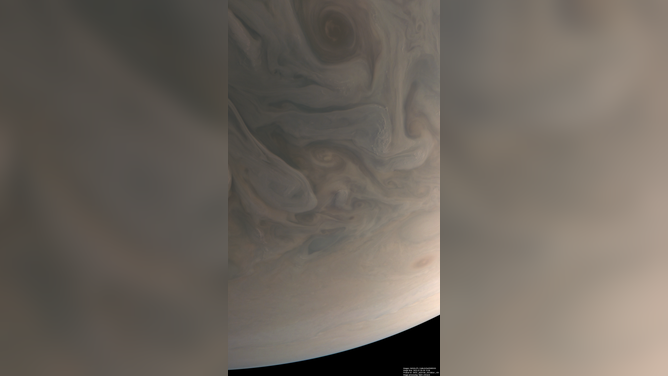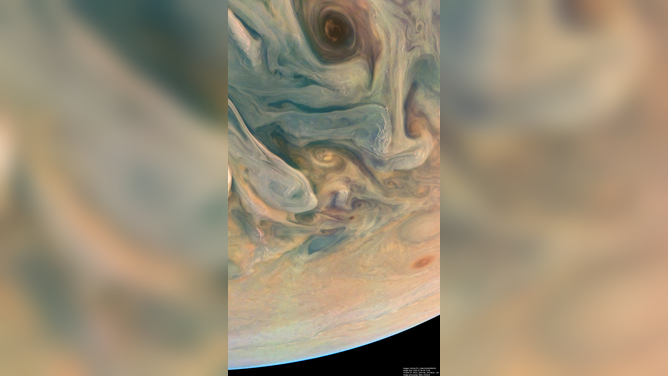Swirling clouds of Jupiter star in new images captured by NASA spacecraft
The image reveals chemical reactions going on in Jupiter's atmosphere, swirling vortices and bright clouds that 'pop' in the higher parts of the planet's atmosphere.

Citizen scientist Björn Jónsson created these two images using raw data from the NASA Juno spacecraft's JunoCam instrument. At the time the raw image was taken, Juno was about 3,300 miles above Jupiter’s cloud tops. (Image data: NASA/JPL-Caltech/SwRI/MSSS Image processing by Björn Jónsson © CC NC SA)
Jupiter's forecast always includes cloud cover and giant swirling vortices covering the giant gas planet, and those weather features were recently on beautiful display in images captured by NASA's Juno spacecraft.
NASA highlighted some images taken in July by Juno's high-resolution camera instrument, known as JunoCam. The two pictures above were created using raw JunoCam photos and processed by citizen scientist Björn Jónsson.
The image on the left was processed to show colors that a human eye might see from Juno's vantage point. The version on the right was enhanced to increase the color and saturation, which helps sharpen small features and reduce noise.

The image was processed to portray the approximate colors that the human eye would see from Juno’s vantage point. (Image data: NASA/JPL-Caltech/SwRI/MSSS Image processing by Björn Jónsson © CC NC SA)
With some fine-tuning, the image reveals some chemical reactions in Jupiter's atmosphere and swirling vortices, as well as the small bright clouds that "pop" in the higher parts of the planet's atmosphere. The result looks like a beautiful watercolor painting.
YOU CAN HELP NASA ID DIFFERENT TYPES OF STORMS IN JUPITER’S ATMOSPHERE
According to NASA, the image was taken when Juno was 3,300 miles above Jupiter's cloud tops at a latitude of about 50 degrees, and the spacecraft was moving at 130,000 mph.

The second JunoCam image was digitally processed to increase both the color saturation and contrast to sharpen small-scale features and to reduce compression artifacts and noise that typically appear in raw images. (Image credit: Image data: NASA/JPL-Caltech/SwRI/MSSS Image processing by Björn Jónsson © CC NC SA)
The Jovian weather is what creates the interesting stripes and swirls you might think of when you picture the planet. Clouds of ammonia and water are floating in an atmosphere of hydrogen and helium, according to NASA. Jupiter's largest weather system, the Great Red Spot, is a storm bigger than Earth that has been ongoing for hundreds of years.
Citizen scientists like Jónsson are a big part of JunoCam. Professional and amateur astronomers can contribute to JunoCam by uploading their telescopic images taken from Earth to help the JunoCam team decide on its next Jovian image objectives.
Another image (below) processed by Jónsson was also taken during the July flyby, or Perijove 43. In the right and bottom, more bright white "cloud pop-ups" are visible on top of the blueish vortices.

An enhanced Juno spacecraft image taken in July 2022 showing vortices and cloud "pop ups" in the Jovian atmosphere. (Image: NASA / JPL-Caltech / SwRI / MSSS / Björn Jónsson © CC NC S)
JunoCam's images are uploaded to the mission website, where anyone can process and upload their creations.
Juno isn't the only spacecraft observing Jupiter. The newly commissioned James Webb Space Telescope recently captured images of Jupiter's Great Red Spot, auroras and swirling weather. Another citizen scientist also processed those high-resolution images.
NASA's Juno spacecraft has been orbing Jupiter for more than six years, gathering new images with every orbit. The spacecraft made its 44th overall and most recent orbit of the gas giant on Aug. 17. Juno is expected to make nearly 80 passes of Jupiter through 2025.